
This semester started off with a bloody bang. I was told my first assignment, and excitedly I hurried off to get some Bristol to create study models. I marked out the 1" bands of Bristol strips carefully, drew my ever so light line across the sheet, placed my straight edge right next to but not too close to the line I was about to cut, and unsheathed my Olfa knife ready for action. I pulled it downward across the page. Slowly at first, carefully, the faster with purpose and confidence. The blade then sunk right into my left index finger and immediately I snapped my hand back away from the paper. We all know keeping the paper clean is the most important thing. My finger poured blood for a good 10 minutes while I attempted to bandage it up. 30 minutes later my bandage was filled again and I had to redress it. What a way to kick off the spring semester.
Our first project is the oddball of the first year second semester courses. Most studios are working in "found wood" to create spatial fabrics (or so it seems). My studio, under the direction of Che-Wei Wang, is taking a different approach entirely. We were given the assignment to extract a 5-15 second clip of a kung-fu flick, and analyze the bodily relationships and they spaces they create, to develop a landscape. We began by studying it frame by frame and compiling the frames onto a sheet, splaying the bodies out according to a set of specific rules. Seen here: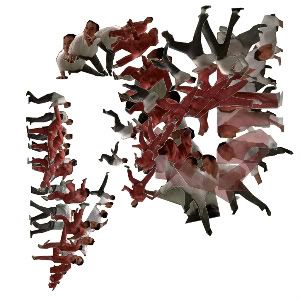
We then began to work with bristol (in the future moving into white oak edging), to create a language of forms based on its own set of rules. The remainder of the beginning stages of this project will be to grow these two elements together, which I assume, it hasn't quite been spelled out for us yet, through a series of tweaking and eliminating certain rules. The outcome so far is quite a mystery to all of us, but we are all very excited to jump into it with both feet.
As for the previous semester's work, I will be telling you the outcome of that work here, in my first Spring semester post.
I'll begin with Technics, the class I dissed with no mercy in the previous post. To be quite short, it redeemed itself. The first project was terrible; the paper plate tower. the second project was a cantilever structure made of basswood and piano wire. It was rather useless for me since I already had a feel for the basic structural forces, however I can see where one who may not have much experience might benefit. The third project was really exciting. We took the cantilever a step further, and were tasked to create a chair for one or more people that cantilevered off a stairwell. Many different chairs were created, and if you can see the Pratt Archive someday I'd say check it out, but this one was my team's (we were archived!). One of my favorite crits about this project was that it was "intriguingly recreational":
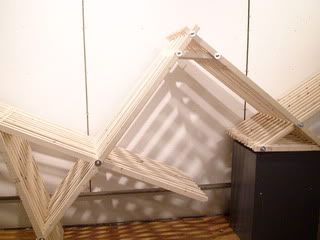
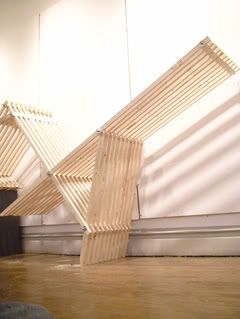
Representation was a rather exciting class, although arguably was paid the least attention. Our last two drawings we were allowed to draw the cubes in motion, and distort them however we felt was appropriate to communicate our ideas. My second to last drawing was a vellum and lightly rendered drawing of the cube accelerating across the page and receiving different angles of light from different points in the day. The shades and shadows changed to illustrate that. The last drawing was again a vellum drawing, lightly rendered. For this drawing I chose to distort it by bubbling the drawing out via a personally developed technique for a ball lens. If you don't know what a ball lens is, imagine a fish eye view of a drawing. I set up a system where based on how far the midpoint of a line was from the center point of the lens, it would be arced a certain degree less than the maximum arc, which was the diameter of the lens. The process produced rather convincing drawings towards the center of the drawing, but the extreme values towards the outer edges of the lens, were skewed and incorrect. I would compare it to being the part of the drawing that is outside of the 60 degree zone of focus when drawing a perspective. Besides this major part of the drawing, the jury loved it. The drawing is here, however, it is not scanned, only a bad phone photo. I have not scanned my work yet: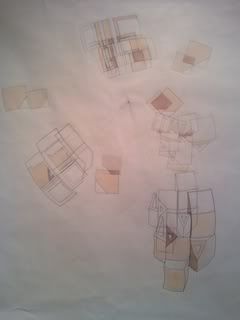
In design, the project we were working on, wood word joints, turned into mayhem of spatial relationships. It was really awesome to see all of my classmates projects take form. The second phase (volume of jointed tales) I will go over really quickly. We turned our 3 3"x3" cubes into a 9"x9" cube with one of the 3x3s as a 9x9, with another one at the 6x6 scale, and 3 more in the 3x3 scale all within the 9x9 volume that has one path to unlock. It took a lot of visualization to design.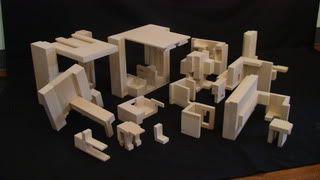
The next stage of the project was to take all the pieces you've just seen in the previous photo, and turn it into an 18" tall, and 18" long L-shape cantilever structure by using a series of primary, secondary and tertiary structural systems that are the same massive pieces, but stripped down to reveal spaces created by the extrusions. That is very simply put for a very complex explanation of the project. The final product was this: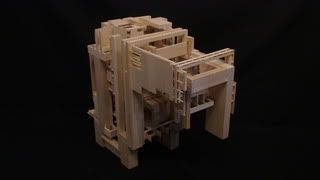
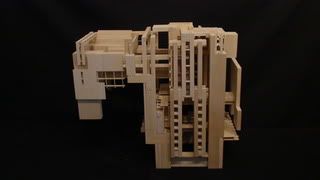
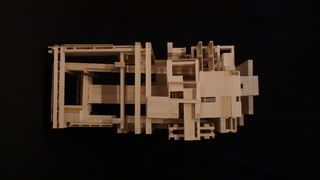
My critique on it was reasonable. I was told my use of skin vs. skeleton could have been better. The terminology I used was rather contradictory to the apparent relationships between said skin and skeleton. But all-in-all it was a fairly well received project that could have been simply improved.
Weird Pratt:
Rat balls. There is a sculpture next to the engineering building (thats weird too, because there is no engineering major.) that is of a rat. It has balls. HUGE ones. They are so big, I didn't even think it was a rat with balls for a long time.
6 Comments
you're now officially an architect! welcome to the club... btw, zap-a-gap does wonders for closing wounds!
Thankfully I've never seriously injured myself, at least in my undergrad career, I'm fairly sure all of our studios have first aid kits in them. I used one last semester just for a band-aid to keep the paper cut from getting any blood on my model.
I wasn't really surprised when I was walking up the stairs one day and seeing a trail of blood drops.
I suppose it's lucky for the more unfortunate of my fellow students that there is a hospital with an emergency room right across the street from the architecture building.
seriously - my classmate almost amputated her finger with the x-acto
There was a few people who nipped off the tips of their fingers in fall semester. Another girl accidentally cut her wrist (scariest of all the injuries), a girl who table sawed directly down into the tip of her finger and another kid who put a drill press through his hand.
Quite a horrible semester for safety!
two months back i was working on a model for the portfolio, and chopped off exactly half the top of my thumb, half the nail and all the way back. it just fell off, the bone was left exposed with the many layers of skin, which were kinda cool to look at until i passed out! they stitched it back in but told me the odds are against its healing and they might have to reconstruct it with my arm or leg tissue. it went white then black for a week then blood starting flowing back in. now it's healed and looks like a burn, slightly darker and without the nail but as good as new. the wonders of the human body..
the good news is the doctor told me back then he's never seen a cleaner cut than mine, and that must make me a good model maker. i still remember that as the highlight of this unfortunate incident. ha!
:)
By code there needs to be one in every studio. But the funny thing was that students would take the supplies like the scissors, tweezers, the towelettes to clean up their zap-a-gap containers, bandages to hold up their models and such, basically for any physical model purposes and not for emergencies. So by the 3rd week, there would be no supplies and some poor sap screaming out of the woodshop gushing blood from his finger would be shit out of luck only to find an empty beer can and a used condom in the first aid kit.
Block this user
Are you sure you want to block this user and hide all related comments throughout the site?
Archinect
This is your first comment on Archinect. Your comment will be visible once approved.